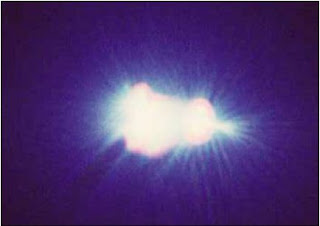Hydrodynamic cavitation
This type of cavitation is produced when the pressure in the liquid systems (e.g. ship propellers, pumps, turbines, hydrofoils and nozzles) drops below the saturated vapor pressure. Cavitation of hydraulic machinery has been well-documented in Prof. S.C.Li's book (Li, 2000). For most cases, cavitation can cause severe damage to the materials and should be avoided in hydraulic machinery.
Cavitating vortex in the draft tube of a Francis turbine. Adapted from Fig.7.10 of Brennen (1995). Link
(a)
(b)
Cavitation caused damage on the wicket gate (a) and region between wicket gate and crown (b) of Francis turbines, Three Gorges Power Station, China. Adapted from Fig.5&7 of Li(2006).
Acoustic cavitation
This type of cavitation refers to the nucleation, growth and collapse of bubbles under acoustic waves. This kind of cavitation has boosted many interdisciplinary subjects, e.g. sonochemistry, sonoluminescence, sonoporation etc. It has been widely used for kidney stone crush (lithotripsy), gene transfer and non-invasive cancer treatment.
Colour Photograph of the light emitted by a trapped, positionally stable bubble. Frame size is 1 mm×1 mm. Courtesy of R Geisler. Adapted from Lauterborn and Kurz (2010, Fig.70)
SEM micrographs of cells after sonoporation and fixation. The cells were insonated with 2.25 MHz and 570 kPa peak negative pressure pulses in the presence of MBs. (a) MAT B III cells; (b) red blood cells. Adapted from Mehier-Humbert et al. (2005).
Optic cavitation
Single vapor bubble dynamics. The movie is taken with 1 million frames/s, and the image width is 140microns. Courtesy of C.D. Ohl.
Bubble-boundary interaction. Courtesy of C.D. Ohl.
Particle cavitation
Besides photons in optic cavitation, other elementary particles (e.g. protons; neutrinos) can also generate cavitation bubbles. When the high energy particles pass the mediums, a small fraction of mediums will be ionized and rapidly heated, resulting in tiny bubbles.
References
Brennen, C. E. (1995). Cavitation and bubble dynamics. Oxford University Press.pdf
Lauterborn, W. (1980). Cavitation and inhomogeneities in underwater acoustics, Springer-Verlag, pp.3-12.
Li, S. C. (2000). Cavitation of Hydraulic machinery. Imperial College Press.
Li, S.C.(2006). Challenge to Modern Turbine Technologys: Analysis of Damage to Guide Vane Surface of Three Gorge Turbines. Proceedings of 1st Int. Conf. on Hydropower Tech. & Key Equip., Beijing.
Mehier-Humbert,S., Bettinger, T., Yan, F. and Guy,R.H. (2005). Plasma membrane poration induced by ultrasound exposure: implication for drug delivery, J.Control. Release, 104, 213–222.
Shah, Y.T., Pandit, A.B. and Moholkar, V.S. (1999). Cavitation reaction engineering, Kluwer Academic/Plenum Publishers, New York, Chap.1.Link
.jpg)







!
ReplyDelete